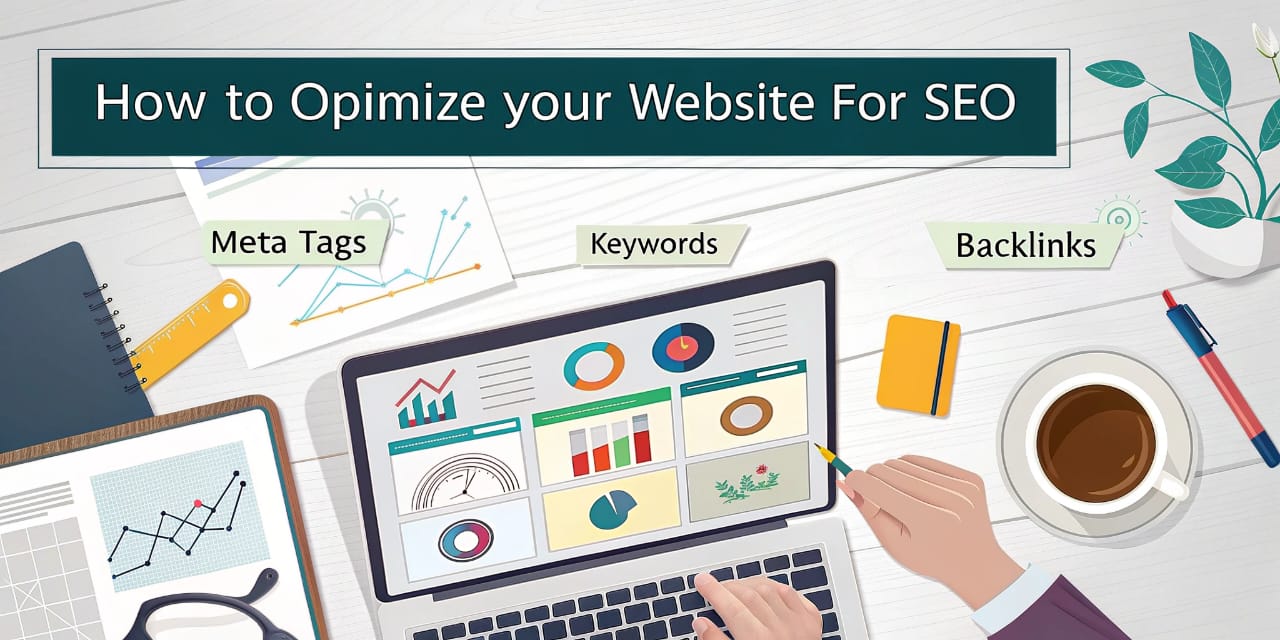In today's digital world, having a website is not enough—people need to find it. Search Engine Optimization (SEO) helps your website rank higher on search engines like Google, driving more traffic and building trust with your audience. This blog will guide you through practical steps to optimize your website for search engine optimization, from keyword research to technical improvements, so you can boost visibility and grow your online presence.
What is SEO?
SEO stands for Search Engine Optimization. It means improving your website so that it shows up higher in search results on Google or other search engines—without paying for ads. The goal is to help more people find your website when they search for something related to your business, services, or content.
For example, if you have a Digital Marketing Institute in Jaipur and someone types "best digital marketing institute in Jaipur" into Google, good SEO can help your website appear near the top of the results. This way, more people can visit your website and become your customers.
Search engines like Google follow a simple process:
- Crawling – They use special software (called bots) to explore your website and read your pages.
- Indexing – They save your website's content in their database so it can be shown to people when needed.
- Ranking – When someone searches for something, Google tries to show the most valuable and relevant websites at the top.
To make SEO work for you, your website needs to be easy to read, helpful for users, and well-organized. It should also include the right keywords (words people are searching for), load quickly, and work well on phones.
In short, SEO helps your website:
- Get more visitors
- Reach the right people
- Build trust and credibility online
Types of SEO
SEO has different parts, and each one helps your website differently. To get the best results, it's important to work on all of them. Let's look at the main types of SEO in simple words:
On-Page SEO
This is about improving everything on your website to help it rank better on search engines.
It includes:
- Use the right keywords in your titles, headings, and content.
- Writing clear and useful descriptions (meta descriptions) for each page.
- Add images and make sure they have names that describe them (alt text).
- Make your content easy to read and organized with proper headings (like H1, H2, etc.).
Goal: To help search engines and people understand what your page is about.
<!-- /wp:paragraph -->Off-Page SEO
This is about building your website's reputation and trust through actions taken outside your website.
It includes:
- Getting backlinks, which are links from other trusted websites pointing to your site.
- Being active on social media—when people share your content, it shows you're valuable.
- Having other websites mention your brand, even if they don't link to you.
Goal: To show search engines that other people trust your website.
Technical SEO
This focuses on how your website works behind the scenes. A well-built site is easier for search engines to crawl and index.
It includes:
- Make sure your website loads quickly.
- Fixing broken links and errors.
- Creating a mobile-friendly design.
- Make sure search engines can easily find and read all your pages.
Goal: To make your site fast, easy to explore, and free of problems.
Local SEO
Local SEO helps your business show up in location-based searches, like "best digital marketing course in Jaipur" or "digital marketing institute near me" searches.
It includes:
- Adding your business to Google My Business.
- Getting listed in local directories (like Justdial or Sulekha).
- Use local keywords, such as your city or area name, in your content.
🚀 New Batch Starting Soon!
Don't miss your chance to enroll now.
Goal: To attract nearby customers who are looking for services like yours.
Mobile SEO
This makes sure your website looks and works well on phones and tablets, as many people now search on mobile devices.
It includes:
- Use responsive design so your website adjusts to any screen size.
- Making sure pages load quickly on mobile.
- Ensuring buttons, text, and images are easy to use on smaller screens.
Goal: To give a smooth and fast experience to mobile users.
Each type of SEO is important. When combined, they help your website rank higher on search engines, bring in more visitors, and grow your business online.
How to Optimize Your Website for SEO
Search Engine Optimization (SEO) helps your website appear higher on search engines like Google. When your website is properly optimized, more people can find it, visit it, and take action, like buying something, reading your blog, or contacting you. This guide explains how to optimize your website step by step.
Do an SEO Check-up (SEO Audit)
An SEO audit is like a health check-up for your website. It helps you find and fix issues that may prevent your site from showing up well in search engines.
Useful tools:
- Google Search Console – Shows how Google sees your website and helps find errors.
- Screaming Frog SEO Spider – Checks for broken links, missing tags, and more.
- Ahrefs or SEMrush – Analyze your backlinks, keywords, and technical SEO issues.
Check the following:
- Site speed – Make sure your site loads quickly. Use Google PageSpeed Insights to test it.
- Mobile usability – Your website must work properly on phones and tablets.
- Crawl errors – Fix any problems that stop search engines from reading your site.
- Index coverage – Make sure important pages are indexed (added to Google's list).
Find the Right Keywords (Keyword Research)
Keywords are the words people type into Google. You need to use the right keywords to attract the right visitors.
Tools to help:
- Google Keyword Planner – Shows search volume and related keyword ideas.
- Ubersuggest – Offers keyword suggestions and competition data.
- SEMrush or Ahrefs – This shows what keywords your competitors are using.
Types of keywords:
- Short-tail keywords – Broad words like "digital marketing." They have high competition.
- Long-tail keywords – More specific phrases like "best digital marketing course" are Easier to rank for and attract more interested visitors.
Tip: Think like your audience. What would they type into Google when looking for your service or product?
Improve Your Pages (On-Page SEO)
On-page SEO means making changes on each page of your website so search engines and visitors can understand and enjoy the content.
Key things to optimize:
- Title Tags – Use clear, short titles with your primary keyword.
- Meta Descriptions – Write short summaries of each page to appear in search results.
- Headers (H1, H2, H3) – Use heading tags to organize your content.
- URLs – Keep them short and include your keyword. For example, www.yoursite.com/seo-tips
- Images – Name your images clearly, use alt text to describe them, and reduce their size to load faster.
- Internal Links – Link to other useful pages within your site to help users and search engines move around.
Create Helpful Content (Content Optimization)
Your content should be original, easy to understand, and solve your visitors' problems.
How to write better content:
- Write about topics your audience cares about.
- Avoid copying from other websites.
- Use your real experience and knowledge.
- Follow Google's E-E-A-T: Experience, Expertise, Authoritativeness, and Trustworthiness.
- Use keywords naturally in your content.
- Break text into short paragraphs and use bullet points and subheadings.
Fix Technical and Mobile Issues (Technical SEO)
Technical SEO makes sure your website works well behind the scenes so that search engines can read and understand it.
Focus on these areas:
- Mobile-Friendly Design – Your site should work well on all screen sizes.
- Fast Loading Time – Compress images, remove extra code, and use a fast web host.
- HTTPS – Use a secure website connection (SSL certificate).
- XML Sitemap – A file that lists all your important web pages for Google.
- Robots.txt File – Tells search engines which parts of your site to crawl or ignore.
- Structured Data (Schema Markup) – Adds extra details about your content (like reviews, products, events) to help Google understand your pages better.
Promote Your Website (Off-Page SEO)
Off-page SEO helps build your website's authority and trust by getting links and attention from other places on the internet.
Key strategies:
- Get Backlinks – When other websites link to your site, it shows search engines that your content is trusted.
- Guest Blogging – Write articles for other websites and include a link back to your own.
- Share Content on Social Media – Promote your blogs and pages on platforms like Facebook, Instagram, and LinkedIn.
- Online Reputation – Get good reviews and respond to customer feedback.
Tip: Focus on getting backlinks from quality websites related to your topic.
Optimize for Local Searches (Local SEO)
If your business serves a specific city or area, Local SEO helps nearby customers find you.
How to do Local SEO:
- Google My Business – Create a profile with your business name, address, phone number, and hours.
- Local Keywords – Use phrases like "electrician in Jaipur" or "top bakery near me."
- Customer Reviews – Ask satisfied customers to leave reviews on your Google profile or other platforms.
- Local Listings – Add your business to local directories like Justdial, Sulekha, and Yelp.
Track Progress and Keep Improving (Monitoring and Updates)
SEO is not something you do just once. You need to monitor your website's performance and keep updating it.
Use these tools:
- Google Analytics – See how many people visit your site, where they come from, and what they do.
- Google Search Console – Track your keywords, fix errors, and see how your pages appear in search results.
Ongoing tasks:
- Update old blog posts with new information.
- Add new content regularly.
- Fix broken links or outdated pages.
- Monitor your rankings and traffic over time.
Conclusion
Optimizing your website for SEO is not a one-time job—it's an ongoing process that requires regular updates, learning, and effort. From choosing the right keywords to improving technical performance and creating helpful content, every step plays an important role in making your site more visible and valuable.
By focusing on all aspects of SEO—on-page, off-page, technical, local, and mobile—you can help your website reach more people, rank higher on search engines like Google, and build long-term trust with your audience. Start with small improvements and stay consistent. Over time, your website will grow stronger, attract more visitors, and support your business goals more effectively.


